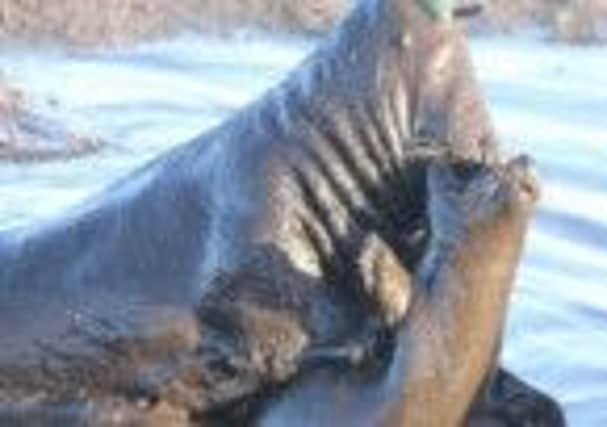Cannibal seals behind mystery deaths in Scotland


Marine experts had been left baffled by unusual spiral injuries found on a number of dead seals washed up around Scotland.
Between 2009 and 2014, 86 carcasses were found with single, smooth-edged cuts that spiralled around the body.
Advertisement
Hide AdAdvertisement
Hide AdExaminations of the damaged corpses led to the conclusion that the seals had died as a result of getting sucked into ducted boat propellers – used on vessels that need to move slowly or remain stationary.
Other research has suggested shark attacks could have caused the massive injuries.
But new research from the University of St Andrews suggests male grey seals are most likely to blame.
Scientists at the university’s Sea Mammal Research Unit (SMRU) witnessed an adult male grey seal killing five young seals at a colony on the Isle of May, biting off chunks of blubber and leaving the dead animals with distinctive spiral injuries. Combined with recent similar evidence from Germany, the findings suggest that such predatory behaviour may be more common than previously thought and could explain the unusual clusters of injured seals found in Scottish waters.
FOLLOW US
SCOTSMAN TABLET AND MOBILE APPS
The new evidence does not eliminate ship propellers, but the researchers say it is now less likely they are a key factor.
SMRU’s Dr David Thompson, said: “Grey seal males have been recorded killing and eating pups in the past.
“This is the first time we have been able to get thorough post-mortem analyses of the carcasses, and it has flagged up the fact that the wounds are the same as those previously identified as propeller and or shark injuries.
“In combination with recent reports of grey seals eating porpoises and harbour seals, these observations suggest that grey seals are acting as a top predator in the North Sea.”
Advertisement
Hide AdAdvertisement
Hide AdThe latest studies, carried out between November and early January, show a single adult male grey seal was responsible for at least eight of the deaths on the Isle of May.
A further six dead animals were found near the same spot with similar injuries.
The report describes one incident where the seal was seen to grab a pup by the scruff of its neck and drag it to a freshwater pool. The attacker then climbed on top of the pup and held it underwater until it stopped moving – even though it was still alive.
The male then tore a strip of blubber from the back of the youngster’s neck and swallowed it whole. This behaviour continued for more than 40 minutes, before the marauding grey seal fell asleep on top of its victim’s body.
The report suggests the same animal could also have killed seals in Helgoland, a German archipelago in the North Sea.
The animal has been fitted with a tagging device, which shows it is currently heading towards a grey seal breeding colony on the islands.
Environment secretary Richard Lochhead said: “The clusters of corkscrew seal deaths were unusual and worrying.
“In common with many of the creatures that live in our seas, seals are animals that are loved by the public.
Advertisement
Hide AdAdvertisement
Hide Ad“It is very important that we understand what caused these unusual deaths and we now have important evidence that natural predatory behaviour is likely to be the main cause, rather than ship propeller injuries as we first thought.
“This provides some reassurance for the shipping industry.”
Marine Scotland is continuing to monitor populations for any further injuries.